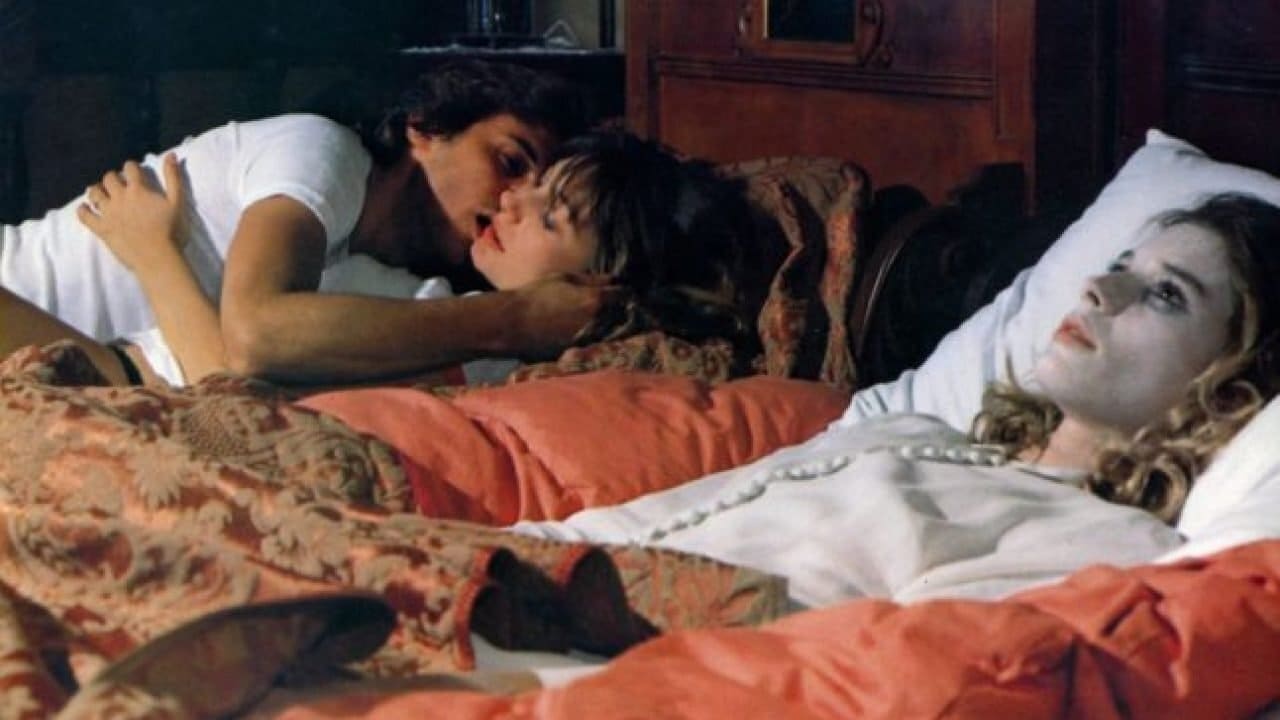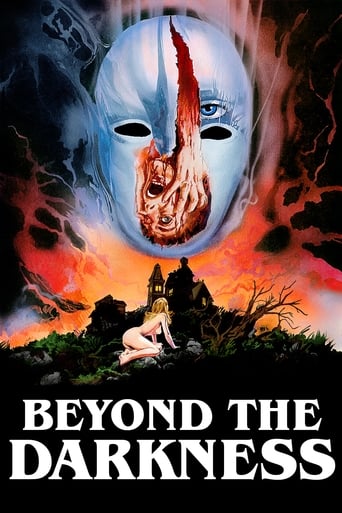



Very well executed
It isn't all that great, actually. Really cheesy and very predicable of how certain scenes are gonna turn play out. However, I guess that's the charm of it all, because I would consider this one of my guilty pleasures.
View MoreThe film creates a perfect balance between action and depth of basic needs, in the midst of an infertile atmosphere.
View MoreIt's simply great fun, a winsome film and an occasionally over-the-top luxury fantasy that never flags.
View MoreD'Amato's notorious horror film is a glorious amalgam of Poe (The Premature Burial), Franju's Les yeux sans visage, Hitchock's Psycho and the furthest reaches of Freudian psychology, with the Oedipus complex finding its climax in an act of castration by the mother imago. It's a compelling and repellent film, an astonishing feat of visual storytelling and an overwhelming mesh of stunning cinematography, fierce editing and driving disco-infused score courtesy of The Goblin. D'Amato manages to both create one of the most punishing nasties in the horror cannon whilst at the same time leaving us with some truly visionary images of twisted love, obsession, death and decay.The story, unlikely to the rational mind but with the clarity of a dream, tells of a young orphaned heir to a fortune, living in a mansion and spending his time at his favourite pursuit, taxidermy. His insane governess/surrogate mother colludes with an occultist to put the voodoo on the heir's fiancée, causing the beautiful girl's death, which coincides with a kiss he gives her on her hospital bed. Breastfeeding by his governess does little to console our hero, so he disinters his beloved's corpse, brings it home and stuffs it as he has been stuffing various animals. Yet, as so often in drama, one crime leads to another and another, as various young women have to be dispatched after they stumble on his secret. But this state of affairs can't continue, and society in the shape of a greedy mortician who witnessed the body stealing gradually catches up with him, but normality is only restored by the death of our hero and his mad "mother"; her last act is to castrate her errant son.The heir's predicament is visceral and in some ways universal. He wants rationality and normality but is thwarted by the governess, who represents dark forces and old magical ways (there's a touch of Medea about her). Her spell prevents him from being with his perfect love, but she aids and abets him in maintaining the embalmed corpse of that dream, at the same time as protecting him from the outside world. One extraordinary scene has the heir bringing a young woman into his bedroom and making love to her in the bed next to the stuffed cadaver of his betrothed – he ruts on top of the new girl whilst staying fixated on the old, and when the new girl notices the corpse in the bed, she screams and meets her end by being ravaged, bitten and partially devoured by the crazed young man.The taxidermy sequence is stomach-churning in its explicitness, and was notorious at the time of release because of rumours D'Amato had used read corpses in the filming. Cuts are explicitly studied by the camera, entrails are unravelled from the stomach, the heart is removed, kissed and bitten into by the love-sick male. To love somebody is to love their body, but the implications of this when the body is deceased is a horrific extension of the loving instinct, and what gives the film its power. The film concentrates on the fate of the body after death, with burials, cremations, dismemberments, taxidermy, rendering in acid all shown in lurid detail. The film is partially about the sea changes that these processes wreak on the body. The most striking of these is the acid bath, where the fleshy corpse of a victim is submerged only for the head to rise again, just a pair of eyes in and a ragged mop on a grinning skull, the death's head. The rendered remains are finally poured into the garden, to disappear into the ground of an unconcerned nature. The film confronts the most terrible truths about death, the body, desire and warped human relationships, and shows us no way out other than death.Eventually, the dead fiancée's sister shows up at the mansion and things come to a head. The heir seems to realise that the living thing is better than the dead, but the governess won't allow this, emblematic guardian against life that she is, and she runs at the heir with a knife looking exactly like Norman Bates dressed as his mother. The knife cuts into the young man's sex, the fruition of that castration anxiety which Freud posited as a deep-seated fear in boys and young men. He and the crazy faux-mother rip and bite each other, bringing both of them to their doom. The mortician finds what he takes to be the stolen corpse, and returns it to its coffin, but it's the living sister (mortified into a state of paralytic shock), and she finally bursts from the grave, maddened with horror.That crazed lady escaping from the jaws of death, reborn from the coffin, is the visual paradigm of the audience at the end of this stunning film – a movie which truly takes us beyond the darkness and brings to light the rotten, the warped, the weird and the dissolutions which we'd prefer not to be confronted with, except in the genre of horror, of which this is surely a masterpiece.
View MoreYes, this is definitely a guilty pleasure. And the guilt comes from giving the movie a 7. It doesn't deserve that high of a rating. None of the film's alternate titles really seems to quite fit. And D'Amato's direction is run of the mill. A rousing soundtrack by Goblin is a highlight(I prefer this soundtrack to Suspiria's). The biggest complaints are the hand-held shots, which are slipshod, and the beautiful countryside setting is almost completely ignored. Also, the dubbing is atrocious, but you just have to expect that with old cheesy foreign movies. There are a few people speaking during the dinner scene who don't have moving lips.And now, I shall gush. The reason why I watch this repeatedly is due to the presence of the severe, the exquisite, the succulent Franca Stoppi as house governess or whatever she is suppose to be. Her hair in a bun, her always-conservative dress hanging off her whisper of a body, well, I guess I'm probably in a minority, but she's nails. And her portrayal of Iris is delicious and devious. It's fortunate she was allowed so much screen time. Frank and Iris and Anna have a rather unusual relationship. Anna is dead because Iris wants young Frank for herself. Iris employees a local gypsy to perform a bit of voodoo to drive Anna into the grave. But Frank's having none of that, so he steals her body from the boneyard(a woefully mismanaged scene that has the casket only about 1 foot below the soil). In a fantastic autopsy scene that would make Savini cry, all of her organs and her brain are removed so Frank, a taxidermist, can preserve her. He keeps her in his bed so he can kiss and fondle her corpse. Iris takes it in stride and helps dress the corpse and even paint the fingernails. She knows this is just a phase(and what a phase!) and in good time, Frank will be hers. A few girls fall afoul of Château Frank and are murdered, with the smirking Iris helping the process along by dismembering a body and helping give it an acid bath or tossing a corpse in the incinerator. Eventually, she grows tired of the game and demands Frank dispose of Anna's body once and for all so he will belong to Iris. But, Frank has grown quite attached. Two scenes to further highlight the strange relations between Frank and Iris show the young man suckling at the older governess's breast and then Iris giving him "a hand up" while he pines over Anna's body.D'Amato gives a few solid scenes. My two favorites are when Frank loads the freshly disinterred Anna into the side of his van(a super creepy red, windowless jalopy that would make Ted Bundy jealous) and the interior shot looks like she's going back into a grave or coffin, and when Frank is on his way home with a hitchhiker and the back window of the van's cab opens slightly, and the deathly white hand of Anna slides out, bobbing along with the twists and turns in the road dangerously close to the hitchhiker's head. Very effective.Towards the close of the movie, Iris has had enough of all this weirdness, and in her best Mrs. Bates, she stalks through the dark to kill Anna's twin sister. She must have a killer knee, because she kicks Frank in the crotch and he starts bleeding all over the place through his trousers(wince). It's a showdown between Frank and Iris that ends rather bad for both of them, but not before Frank can give a final twist to the plot. Highly recommended for fans of the sick.
View MoreWhen the wealthy orphan taxidermist Frank Wyler (Kieran Canter) loses his beloved fiancée Anna Völkl (Cinzia Monreale), victim of voodoo conducted by his jealous housemaid Iris (Franca Stoppi), he robs her corpse, embalms and brings to the bed in his room. He does not overcome his feelings for her, killing every woman he has some involvement. Meanwhile Iris wants to marry Frank and helps him to dispose the bodies.The sick, twisted and kinky "Buio Omega" has all sort of perversions and disgusting scenes, with sequences of necrophilia, mutilation, torture and embalming. However, the characters are awfully developed, and the viewer never knows, for example, whether Frank changed his behavior after the death of Anna, or he was indeed a twisted character. The weird Iris is also badly developed. The graphic and gore scenes are among the nastiest I have ever seen in a film. My vote is six.Title (Brazil): Not Available
View MoreSickening but effective drive-in fare: if you can take the acid-bath/dinner scene, good luck! Reminds me of schlock/grossout fare like DEVIL TIMES FIVE and DON'T LOOK IN THE BASEMENT, only nastier.D'Amato was a workingman's director who didn't seem to care much about the content; an Italian William Beaudine; he was, however, far better than Jess Franco!From the IMDb bio:During the 1980s and 1990s D'Amato directed over 100 hardcore porn sex films for the Italian video market, although under his many pseudonyms he continued to direct and produce other films. One of them was Deliria (1987) directed by Michele Soavi on which, under his real name, Massaccesi served as producer. He then directed two "Ator the Invincible" films. He directed the violent, hardcore Caligola: La storia mai raccontata (1982), using the name "David Hills", a commercial exploitation (some might say "rip-off") of the successful film by Tinto Brass.His long film career came to an abrupt end when, in January 1999, he suffered an unexpected and fatal heart attack at his home in Rome. He was 62. Joe D'Amato had made his mark on Italian cinema as a talented director, scriptwriter, producer and cinematographer with scores of films and more than a dozen aliases to his credit.
View More